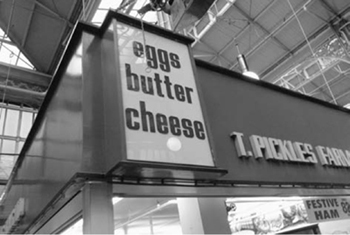
Will Alsop’s proposal for a northern ‘Supercity’ was perhaps the boom’s only good idea, and was practically lost amidst its many vacuities. Unveiled in 2005 at an exhibition in Urbis, Manchester, and subsequently published as a book, Supercity entailed stringing public infrastructure along the M62 corridor to create a twenty-first-century metropolis out of Victorian industrial towns. Alsop placed the North at the centre of the UK, apparently with the brief support of John Prescott in his vague role as overseer for architecture and urbanism.57 Yet Supercity was easily reduced to cliché: what commentators remembered were the actual buildings proposed by Alsop, rather than the far more interesting abstractions behind them; Tuscan hill-towns and signature museums rather than travel networks, piers and viaducts. The ‘West Yorkshire Urban Area’, a conurbation of up to 2.5 million people, exemplifies a good part of what exists instead. Despite having two great and greatly contrasting cities, Leeds and Bradford, at its heart, and a multitude of smaller but often equally architecturally rich towns packed close together, the West Riding is far from unified. Disparities are both its weakness and its greatest strength.
I mainly use the term ‘West Riding’, ignoring its southern part centred on Sheffield, to describe the government-defined ‘West Yorkshire Urban Area’. This is made up of Bradford, Leeds and their many satellites, along with Wakefield and Huddersfield, sometimes with Halifax added to the list; a conurbation that, unlike those other unofficial supercities, the West Midlands, Greater Glasgow, Tyneside or Greater Manchester—all these potential rivals to the bloated, absurdly over-favoured capital which never quite manage to get their act together—is hardly continuous. One part can appear to be on a different planet to another part, which is presumably one reason why, other than the ingrained opposition to planning, the places are all treated as discrete areas, despite the fact it’s easier and quicker (if seldom cheaper) to get from one of these towns to another than it is to get from South-West to South-East London. If this is a Supercity in waiting, it’s an extraordinarily strange one, a multi-centred mess, marked by sharp, shocking geographical and urban/rural contrasts. Although Alsop’s M62 Supercity is a genuinely smart idea, something which, as he rightly points out, is already happening in an exurban, car-driven, environmentally destructive manner but could, if planned, be far more powerful, it should be noted that his actual town plans are less interesting. The plan for Bradford, for instance, is a peculiar bit of whimsy, advocating the recreation of long-covered stretches of river; let’s add a few water features, then it’ll be more like Manchester. There is, however, plenty of water in the Westfield Crater, the huge hole left by Bradford’s most recent and most ill-advised exercise in town planning.
Near the centre of the potential Supercity is the Emley Moor TV tower, the tallest free-standing structure in Britain, which sits alone in the midst of open country, a Stadtkrone monument without a Stadt. So the most obvious thing would be for the hypothetical West Riding Metropolis to be centred around Emley Moor, much as Berlin, Seattle or Toronto cluster round their space-age beacons. Here we will travel around this stretch of the urban West Riding as if it were already a city rather than a cluster of cities and towns, arranging the observations by theme rather than by town.
Surely one of the many reasons the West Riding seems to have produced great urban writers—among them David Peace, Laura Oldfield Ford, Jarvis Cocker and even the now all-but-forgotten J.B. Priestley—is the presence of actual Parisian ferro-vitreous arcades in its cities, something which is otherwise largely limited to outposts in Piccadilly, Deansgate and central Cardiff. Few are as good as these. Leeds has the most obvious examples, and given Leeds’ status as the local mecca for The New Economy—i.e. the post-industrial triad of finance, property and shopping—its examples are best looked after, as a northern Knightsbridge. In 2006 Simon Jenkins hailed Leeds as a traditionalist exemplar for the rest of the country, curious given its inner urban motorway and many towers, but looking round the shopping spaces of the immediate centre, you can see why.58 Civic grandeur and commercial opulence make decidedly comfortable partners, giving streets a similar feel to Regent Street or Deansgate—but fittingly, given the weather, the enclosed spaces are special. The Arcades, mostly restored to an almost suffocating level of opulence, are fantastical, as is the Edwardian megastructure of J. Bagshaw & Sons’ City Markets, while the 1938 concourse of the City Station is a calmer version of the same principle.

Eggs, Butter and Cheese in Halifax Markets
Within the ring road, Leeds is as elegant as it is proud, largely because of these semi-hidden spaces. Normally they are entered through buildings that are not especially interesting, standard if high-spec Victorian piles, which when penetrated reveal their prophecy of the total retail environments of the twentieth century and after. Leeds Arcades, like everything else in the city, appear to be hierarchical. There are two tucked away in places where you wouldn’t know to look unless you’re with a local, and which are relatively down at heel. Yet the rebranded ‘Victoria Quarter’, centred on Frank Matcham’s 1898 County Arcade, is the ferrovitreous fulcrum, where Vivienne Westwood, Harvey Nichols and, with tragic aptness, a boutique called ‘The French Revolution’ make their home. It’s wonderfully effeminate for (in the southern imaginary) macho and stolid Yorkshire, prettily dressed as it is with Parisian ornament and lurid art nouveau mosaics.
Much more exciting, however, are the City Markets, a lanky and gaunt, complex and brightly painted piece of spindly ornamental proto-high-tech, which contains within it a mingled smell of old sweets, paint and wrapping paper, and a welcome bustle and mess absent from the slick opulence of the Victoria Quarter. Again, it’s impossible not to be struck by the formal daring of the interiors and the retardataire pomp of the exterior, Modernist cliché though this may be. The bombastic, imperial stripped classical 1930s Queen’s Hotel contains within it the elegant, deeply American-moderne station concourse, where a restoration job by local architects Carey Jones (of whom more later) has given Wetherspoons et al. an inappropriately Reithian typeface, and advertisements for the Calder Hall business park stress the white-collar nature of the new Leeds. At this point the city that Simon Jenkins thinks is so wonderful effectively ends—although no doubt he is pleased that many back-to-backs, a form of housing considered unfit for human habitation for 150 years, still exist in the city. The other arcades are the Arndales and their contemporaries: Gillinson, Barnett & Allen’s 1964 Merrion Centre, say, with its lost, abandoned basement of greasy spoon cafés and a tiled tower which is a comparative masterpiece by the standards of the post-1997 Leeds Skyline. Inside, the use of mirrored glass creates an imaginary geometric space that reflects the uninteresting collection of chain stores therein in odd ways. The Merrion Centre argues that Modernists couldn’t quite invest commerce with the same drama as the Victorians could. That theory is belied in Huddersfield, where the Seymour Harris Partnership’s Queensgate Market, with its Mesoamerican ornaments and concrete vaults, creates an ambitious space that makes everyday market trading suddenly surreal.
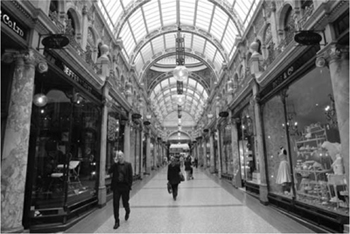
The Victoria Quarter
Leeds City Markets

Moderne Wetherspoons
Wakefield must have wanted a piece of all this when it commissioned David Adjaye, the young and recently bankrupted architect best known for his London ‘Idea Stores’, a pair of barcodefaçaded libraries in East London, to design its new market. To Adjaye Associates’ credit, they provided a striking but far from ostentatious or meretricious structure, clearly designed as a mere backdrop to the more important action of the stalls themselves, admittedly the opposite approach to the Arcades of Leeds and Halifax, which impress through opulence rather than rectitude. If the complaints in the local press are any indication, the market is loathed in Wakefield—a place where, for the first time, I felt like I was somewhere familiar, which is why I haven’t given that town as much attention as others. It felt like a southern city. I appreciate this is probably the worst thing anyone could say to Wakefield, so it has my apologies.
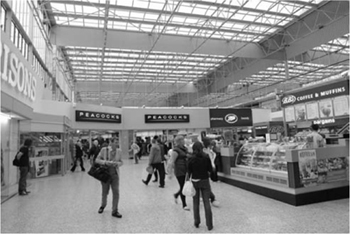
Merrion Centre
Adjaye’s new Wakefield Market
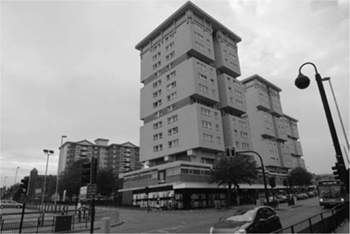
Wakefield’s Ridings
The city’s main new shopping centre, aside from the Market Halls, is The Ridings, a standard-issue mall which occupies part of a 1960s megastructure, several towers, arranged in zig-zags on top of a shopping street. I have no idea whether the complex was once impressive or whether it was shoddily done, but today—like all the tower blocks in Wakefield—it is painted in desperately jolly colours, and wears an absurd hat. No doubt if the blocks were falling apart before this is a preferable condition, but it should be noted that as in cladding-crazy Glasgow, the entire housing stock has been sold to a housing association, which seems keen on these kinds of ‘solutions’. The end result is that Wakefield becomes bleakly surreal in its total lack of all-over planning. Take the exit from the all but ruined Wakefield Kirkgate—reckoned to be the worst major rail station in Britain, and where part of the station wall collapsed last year, smashing a parked car. You emerge to find a large, burnt-out and boarded-up pub and tower blocks seemingly redesigned by a five-year-old as an entrance. Regardless, Wakefield feels normal, just a bleaker version of normality—and perhaps the council knows this, hence the hiring of Adjaye (and at the unfinished Hepworth Gallery, David Chipperfield) to sprinkle starchitect fairy dust. This approach has been embraced even more extensively in Castleford, where Channel 4 and Kevin McCloud descended to foist wonky bridges and public art on a depressed mining village.
Bradford, meanwhile, is a relief after contemporary Leeds, with a sense of real strangeness, drama and uniqueness. Its railway stations may be pathetic and its Portland stone postwar towers might seem to think they’re in Plymouth, but there’s no denying the murky beauty of the city, which supports its one-time claim that while Leeds was famous locally, Bradford is famed internationally. The local stone is as sombre and powerful as the architecture (usually by local firms such as Lockwood & Mawson), which is mostly neoclassical with experiments in Gothic and Moderne. Yet presumably because of its reputation for poverty and civil unrest, Bradford was largely deprived of the boom’s dubious benefits. From the raised park adjoining the excellent Telegraph & Argus building (and its recent imitation, the Gatehaus) you can survey the vast hole torn in the centre of Bradford which is Blairism’s main Bradfordian legacy. Australian retail developers Westfield had planned to have built and finished a mall here by early 2008, as some local signs still proclaim. In early 2010 they still haven’t started work, nor do they expect to. This failure gives the city the exceptional chance to reject the shopping obsession that has torn the heart out of so many others. The space potentially awaits a park and public housing, if Bradford has the guts.
The first view of Wakefield from Kirkgate
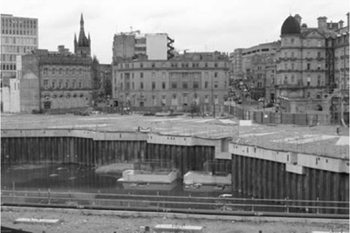
The Westfield Hole
Aside from the hole, the city has gingerly attempted the Mancunian approach to regeneration (Bradford’s industrial buildings are often better; less prettified, more striking in their fusion of utility and sombre classicism), adapting and reusing some warehouses and mills. This works reasonably well in Little Germany, a warehouse district where the likes of the Behrens family traded for decades. This hilltop area is marked by a mural celebrating the foundation of the Independent Labour Party nearby, and presents a series of canyon-like views and rich juxtapositions, particularly at night when it is utterly deserted. As it is, all roads lead to the Westfield Hole, a purple-fenced mass that is impossible to miss, which reorients the city’s geography, its propaganda posters practically insulting Bradford. ‘Urban Energy’, ‘Café Culture’, ‘City Living’; all those Blairite Urban Renaissance clichés. One of them was defaced when we visited by the graffito ‘BEST AMONG RUINS’.
For a southerner, Halifax is another world, a place where ‘Belladonna’, John Cooper Clarke’s paean to an opiated urban Pennine landscape, comes immediately to mind: ‘where the panorama looks like Mars … to the dying gardens, down below …’ The high hills around served as the setting for Wyndham Lewis’s introduction to the North in the 1910s, courtesy of the Vorticist painter and Huddersfield native Edward Wadsworth: ‘[He took] me in his car on a tour of some of Yorkshire’s cities. In due course we arrived on a hill above Halifax. He stopped the car and we gazed down into its industrial labyrinth. I could see he was proud of it. “It’s like Hell, isn’t it?” he said enthusiastically.’59
A century later, waiting at a road junction, looking around at the tower blocks, derelict mills and two-up-two-downs, the sombre local stone, all surrounded by freakishly high impassable hills, themselves enclosed by hedges as if hundreds of miles from a city, the smell of the Nestlé factory wafting over, all under a looming, threatening sky, I said to Joel: ‘This is indubitably the North.’ A voice from a car waiting at the junction agrees, yelling ‘THE NORTH!’ as it drives off. Next to this junction is a pub with the name The Running Man, which fits the general sense of fear and tension perfectly. The Running Man has a rather Googie roof, and a view over the seemingly untouched 1960s estates which have mercifully escaped the hatting given to Wakefield. As we board the Halifax to Wakefield train, some youths ask us ‘Are you FBI?’ Aside from being quite a funny question to ask two men in long coats with neat hair taking pictures, this says more about the Special Relationship between the UK and US than any BBC2 teleplay ever could.
Where the panorama looks like Mars
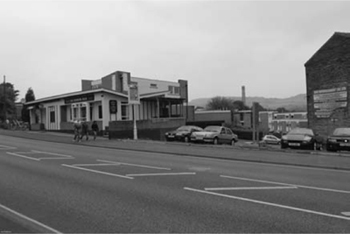
The Running Man
Quite honestly, anyone who knows and/or comes from the industrial towns of the south—say, Southampton, Portsmouth, Reading, Slough or Luton—can’t help being jealous of the sheer strangeness of their Northern equivalents; their hills, their scale, the closeness of open country, the amount of extraordinarily serious, world-class architecture, the lack of 1980s and ’90s tat. Of course, relatively little of this applies in Leeds, which conjured the postmodernist ‘Leeds Look’ in the eighties to simulate Victorian grandeur, with the presumably unexpected end result that much of its outer centre looks like Reading. This is perhaps why it’s the token ‘successful’ northern city along with Manchester, because it’s boring enough for southerners to understand. Civic pride has bizarre, impressive results—inexplicably, Halifax, a town about half the size of Luton, has a Town Hall by the architect of the Houses of Parliament; the rural England/Renaissance Italy Piece Hall; Arcades as good as those in London, Leeds or Manchester; a ‘People’s Park’ which is a model of municipal munificence; and yet you can see where it stops, when the Moors rear up in front of you. And yet all this (admittedly jolie-laide) beauty seems to have no effect. There’s no sense here that city air is free air, but rather an almost all-pervasive air of latent violence that could explode at any moment. We watch indie kids with black eyes cluster together in the Arcades, we get called ‘shirtlifters’ by shell-suited youth. Halifax is the most racially segregated place I’ve ever seen, something that, as Joel points out, even extends to the way the windows in the old terraces are treated—UPVC frames in white areas, new wooden frames in the second/third-generation Kashmiri districts. There’s a certain historical justice that the spaces of imperial philanthropy are well used by the formerly colonized, while the descendants of the colonizers prefer to live in the middle of nowhere, seemingly refusing to take advantage of the extremely impressive town their great-grandparents toiled to create.
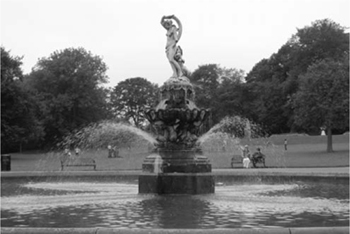
People’s Park, Halifax
The epicentres of late British neoliberalism and its subsequent crash have been those areas once considered resistant to Thatcherism. Scotland with RBS and half of HBOS, Tyneside with Northern Rock, the City of London running riot with the support of a Ken Livingstone administration, and Manchester morphing into a Blairite ceremonial capital. The former Mutuals in the West Riding, Halifax Building Society/HBOS and Bradford & Bingley, are perfect examples of this process; one utterly dysfunctional and propped up by the state, the other now reluctantly entirely nationalized, due in both cases to their over-identification with, their arriviste over-investment in, the new financial architecture of derivatives, credit default swaps and suchlike. Both of these entities have a deeply corporeal, brutally physical presence in their respective towns, expressions of bourgeois civic pride, reminders of the close interlinking of finance and industrial capital in the (post)industrial north. Halifax’s headquarters is genuinely one of the most unbelievable postwar buildings in the country, all the more so for being an early work by BDP, when it was still an idealistic socialist experiment rather than the corporate colossus it is now. To call it dominant would be an understatement, the way it juts out across a Victorian street, but it also harmonizes chromatically with Halifax’s Yorkshire stone, brown and coal-stained black. Finished in 1974, largely designed by BDP collective member Bill Pearson, it combines every possible device in the 1970s architectural arsenal, everything that was in the magazines at that point: flying walkways; black glass Seagram curtain walls; postmodernist incorporation of heritage (the original Victorian façade of their first headquarters can be viewed as an object stripped from its context, behind a glass screen); neo-Constructivist public sculpture; and a series of jarring jigsaw angles which are clearly indebted either to Russian Constructivism itself or the variants upon it which were soon to be known as Deconstructivism. It is all reached by a series of platforms and walkways which replicate the sharp changes in scale of the local landscape. It’s an astonishing building, proof that finance capital was, even over a decade before Lloyds, quite capable of using the devices of ‘left’ architecture.
Bradford & Bingley’s offices, the ‘Hanging Gardens of Bingley’, are relatively normal by comparison but a powerful statement nevertheless, designed by the local firm of John Brunton and Partners, of whom more presently. Sharing Halifax’s grounding in the work of Denys Lasdun (his fusion of the English baroque and Brutalism in buildings like London’s National Theatre or the University of East Anglia in Norwich is so perfect for the West Riding that it’s a minor tragedy he didn’t design anything here himself), Bradford & Bingley’s ziggurat was once planted with creepers, to make this most ancient of architectural forms look appropriately ruined and eternal. Interestingly, now that the building is up for sale and under threat of demolition, the creepers have died, a reminder that ruination is not always picturesque. Otherwise Bingley is an almost-suburban encampment looking out over an (award-winning!) new motorway and the Moors. It’s also now up for sale.
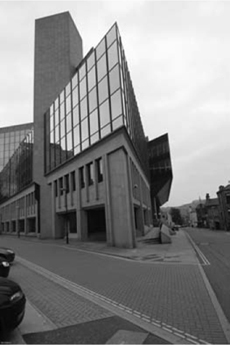
BDP’s Halifax HQ
Constructivist sculpture, Halifax
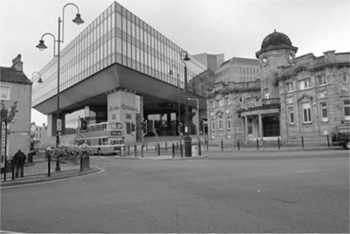
The avant-contextualism of the Halifax HQ
Hanging Gardens of Bingley
One body which has positively thrived after the financial crash is the Co-Operative, a sometimes surprising survivor, its mix of Fabianism and neither-a-borrower-nor-lender-be moralism now combined with Fair Trade ethical consumerism (I write this as a proud member). Its roots are not far away in Rochdale, and West Yorkshire has plenty of monuments to its one-time local power and influence, although for the most part, like any other financial institution, its business is administrated in less high-street places. Apart from its Mancunian HQ, the Co-Op seems wholly uninterested in the fate of its old buildings, which here are striking adaptations of Erich Mendelsohn’s Weimar Republic department stores to the drizzly climate and the local stone, designed by W. A. Johnson and J. W. Cropper. The latter studied radical architecture in the USSR, bringing Communist aesthetics to Fabian functions. The glazed stair tower of the Bradford Co-Op is covered up internally, so we can’t see the no doubt terribly secret operations of its current owners, T. J. Hughes. At least it has escaped the fate of Johnson and Cropper’s other Co-Ops: in Huddersfield, a more original building now threatened with demolition, or the very similar branch in Southport, now occupied by McDonalds. The only one of Johnson and Cropper’s buildings which has been treated with any respect is the one actually still occupied by the Co-Op itself, the CWS headquarters in Manchester.
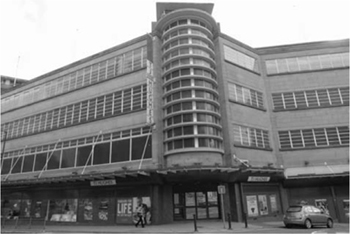
Bradford’s former Co-Operative
In southern towns, except for Bristol (almost an honorary Northern city in its independence from the capital) and Camden-on-Sea (or ‘Brighton and Hove’, as it prefers to be known), arty and ambitious youth tend to escape for London if they possibly can. This is one of many reasons why these places are so aesthetically stunted: all manner of rubbish can be foisted upon them as nobody really cares enough to propose anything better. Local architects in the south are a source of grotesque comedy. This isn’t quite true up north, where the general standard appears once to have been rather extraordinary. Compare the aggressive work of Lockwood and Mawson or John Brunton, who designed much of High Victorian and sixties Brutalist Bradford, with the pallid mediocrity of Southampton’s nineteenth- and twentieth-century hacks Gutteridge & Gutteridge, or W. H. Saunders—these are cities of comparable size and (one-time) importance, after all.
Being commercially driven non-side-takers in the style wars, Lockwood and Mawson were able to indulge in a wide variety of seemingly conflicting manners without fear of contradiction: Ruskinian Gothic (with the explicit disapproval of Ruskin himself) for the Wool Exchange and the Bradford Club; ‘debased’ (according to Pevsner) classicism for St George’s Hall; and an amplified, time-stretched utilitarian man–machine Italianate for the mammoth industrial structures at Saltaire. Planned and designed entirely by the firm on behalf of the Wool Magnate and philanthropist Titus Salt, Saltaire serves as one of the more complete examples of a settlement completely formed by the rationale of early industrial capitalism in its more ‘improving’ variant: a gesamtarbeitstadt, with churches, social centres, libraries but, of course, no pubs, at least originally—the local is called ‘Titus Wouldn’t Like It’. More recently, his other inadvertent legacy is the Titus Salt School. One of two functionally deficient PFI complexes by Anshen + Allen, it was initially boycotted by teachers who were concerned that the buildings compromised the health of their students, a reminder that although the authoritarianism continues, today’s architecture for the deserving poor is of an inferior standard.60 Although the conditions in Saltaire’s housing were far better than those of the surrounding areas—with space, inside loos, orientation to the sun, etc—there’s little attempt to prettify the process, which may explain why it is that its later equivalents, such as Bournville or the Garden Suburbs, massively increased the level of verdancy.
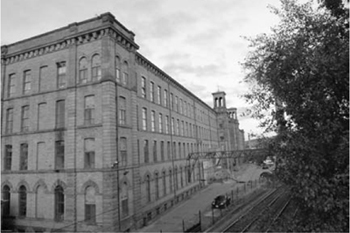
Salt’s Mill, Saltaire
Urban and rural Bradford
For those of us who mourn the passing of the visible world of engineering and design, Halifax, Bradford and Saltaire are exemplary. The city does not pretend to be the country, but the surrounding country, wild and dramatic, is always visible and reachable on foot. Accordingly, Saltaire does not pretend to be a rural village, does not have winding streets, big gardens, gables and beams as do its successors. It is completely unambiguous about its industrial nature. Strangely, then, Salt’s Mill is heaving with cottage industries, as after closing in 1986 and being regenerated over the last decade this became its new function—inside the mills are businesses, galleries, luxury flats and (comfortingly) an NHS centre. A similar transformation has been wreaked upon Dean Clough Mills in Halifax, but Saltaire seems to have as its demographic something that could only exist near to a large city like Bradford: Guardian readers, many of whom are in attendance for a beer festival in Salt’s teetotal temperance outpost (Hebden Bridge has a similar concentration of liberals). The only other ex-factory of a comparable scale is Andrews and Pepper’s Manningham Mills, built two decades later in 1873 by the less philanthropic wool baron Samuel Lister. Almost accidentally, we found ourselves on the trail of the Independent Labour Party that was born here. We ate pizza in the room where the ILP was formed, admired the mural and Terry Hamill’s Constructivistic statue of a worker rising like a lion after slumber, both of which rot outside the buildings where the Party was ‘officially’ founded, and later visited the mills where a long, bitter strike presaged the party’s formation.
Terry Hamill, ‘Untitled’
‘Socialism is the Hope of the World’, says the mural, if you look very closely. The ILP was an enormously admirable organization, always to the left of the compromised Labour Party to which it gave its name and helped to create; leaving it in the 1930s out of anger and frustration with its dogged conformism, it subsequently disappeared within fifteen years. The legacy of New Labour, meanwhile, is best expressed in Manningham by Urban Splash, one of its finest architectural embodiments. Joel is from Manningham, so he was able to show me exactly where the line of burning tyres were placed in front of the fortress-like RUC-esque police station during the 1995 riots, as well as the block of vernacular shops and flats that sits on the site of the car showroom burnt to the ground in the more extensive riots of 2001, when the army was on standby. Manningham is overwhelmingly low-rise and Victorian, something strangely unmentioned in the hand-wringing over the riots; we all know only 1960s buildings cause civil disorder. By far the largest and tallest building is the now Urban Splashed Lister’s Mill. Dressed with a Fosterian series of steel rooftop penthouses designed by David Morley Architects, it looks out on an eerily spacious row of small council houses, with a scrubby park in between. Inside, through the gating that protects it from the surrounding hordes, is a series of red ventilators that are treated as pieces of public art, the most striking example of which is the graffiti round the corner, outside the gates, where it appears the Wu-Tang Clan haunt the area. Deep down in the back streets, in the heart of Medina, about to set off something more deep than a misdemeanour. I always hear about how ‘brave’ Urban Splash are in restoring and privatizing factories and council estates, as if gutting and selling well-constructed city centre buildings is a thankless, risky task (in a recession it suddenly becomes one, hence their current ‘troubles’ and Bloxham’s demotion to a lower rung on the Rich List). There is certainly a daring of some sort in taking one of the most notoriously divided places in the country and building more gates, more walls, reinforcing its divisions—although locals tell us that the division between the new Manningham Mills and the surrounding area is more a question of class than race, with wealthier Bradfordian Asians moving in. So while the best buildings go private, the Victorian situation is replicated; the well-off literally look down upon the poor, who remain in their hovels, left to their sectarian fights while their birthright is stolen in front of their eyes.
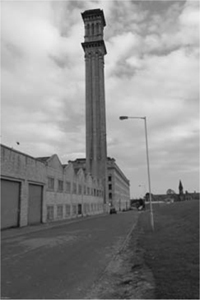
Manningham Mills
Inside the Lister’s Mill gated community
This process is particularly shocking in Saxton Gardens, Leeds. Joel, admittedly a Bradfordian, dismisses Leeds as ‘a bosses’ city’, and there’s an alignment in one particular site which is truly alarming. Once, on Quarry Hill sat an extremely carefully designed council estate full of facilities and public space. It was Britain’s first major casualty of post-sixties municipal anti-Modernism, demolished in the late 1970s. Now a BDP office block nicknamed ‘the Kremlin’ (but resembling more closely Farrell’s MI6 Building) occupies most of the site. In the 1950s the same architect, R. H. Livett, designed the less dramatic, more CIAM standard-issue blocks of Saxton. The juxtaposition there now shows that while the not so poor get ethereal barcode façades and gated-off car parks, the poor get plastic balconies seemingly designed by the same five-year-old who worked on Wakefield. The Urban Splash propaganda apparatus—website, brochure, hoardings—has as its motif garden gnomes, which are apparently going to be everywhere when they finish cladding their second private block, as they will, out of the kindness of their hearts, be laying on allotments. Whether these allotments will remain as imaginary as their oft-praised, never-started Tutti Frutti in Ancoats is worth speculating over. The other local architects worth mentioning here are from the eras of Wilson and Blair; each is equally symptomatic of its time. First, John Brunton and Partners, designers of the aforementioned Bradford and Bingley along with High Point and the Arndale in Bradford. A huge swathe of Victorian Bradford was levelled to make way for the Arndale (now the Kirkgate Centre), and for the Arndale House tower. Local monitors of design like the Bradford Civic Society loathe the Arndale, but in its harsh physicality and its confusion of forms it fits the city far better than, say, the appalling decorated sheds which sit next to Forster Square railway station. It is a mess, full of tat, although the markets in the basement have a certain bazaarlike quality that only seems to exist in the north, and are another place where the oft-alleged racial segregation of Bradford is conspicuous by its absence. It’s all full of almost Barbican-like gridded ceilings and walkways, but in organization is identical to any 1980s mall. There’s another, newer market building in Bradford, where shiny cladding shuns rather than embraces Bradford’s still remarkable architectural cohesion. This is aided in a rather staid, traditionalist manner by buildings like the recent Jamiyat Tabligh-ul-Islam Mosque, whose domes and prickly ornament harmonize with that of the Alhambra theatre and the art deco Odeon. Despite a long-running preservation campaign, the latter is scheduled for demolition and replacement with an obligatory mixed use scheme designed by Leeds’ currently dominant firm, Carey Jones. But all this is overlooked and overshadowed by Brunton’s most unnervingly brilliant building.
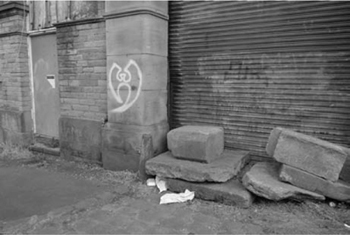
Manningham Wu
Two ways to redesign a council block, Saxton
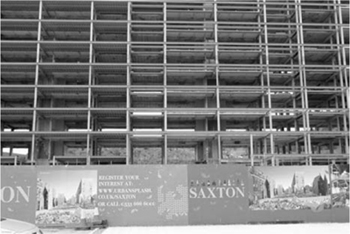
A soon-to-be-bailed-out empty frame at Saxton
High Point, too, is ritually loathed by right-thinking Bradfordians, and was also built for a local financial institution, the somewhat less notorious Yorkshire Building Society. It’s utterly freakish, the severed head of some Japanese giant robot clad in a West Yorkshire stone aggregate, glaring out at the city through blood-red windows, the strangest urban artefact in a city which does not lack for architectural interest. The work of Brunton seems almost too appropriate for the combination of wild technological daring, Cold War paranoia, shabby corruption and crushed dreams that defined the Wilson era. In a similarly neat manner, Carey Jones’s new skyscraper, Sky Plaza, a hall of residence for the extremely prolific developers Unite, was completed in summer 2009 and was receiving its first undergraduate inmates when we visited.
High Point, rising above Bradford Markets
The earliest building of Carey Jones’s that we see, the 1999 Princes Exchange just by the Queens Hotel, is a decent bit of corporate slick-tech, well-scaled, cool and confident, from the time when Blair’s rhetoric about a ‘young country’ might almost have seemed convincing. It’s actually better than some of the 1990s Richard Rogers buildings that it pinches its ideas from. After this, it all goes rapidly downhill. The 2000s redevelopment of Clarence Dock was done mostly by said firm, although it includes Derek Walker’s earlier fierce, bleak Royal Armouries, which we first assume (by now inured to these sorts of shocks) to be flats. Thankfully, even in Leeds the idea of a block with virtually no windows at all couldn’t get through planning. Yet. Leeds is full of Carey Jones’s towers, most of them more or less like Clarence Dock or the ever so slightly more jagged and outré Gateway—not awful, they’d get to that later, just woefully unimaginative. The towers tend to sit by congested, looping main roads, in a city marked by a huge amount of empty inner-urban flats, with none of the oh-so-inhumane underpasses or walkways that could relieve the enormously unpleasant road crossings. Sky Plaza marks the point where they go from dull to positively abysmal.
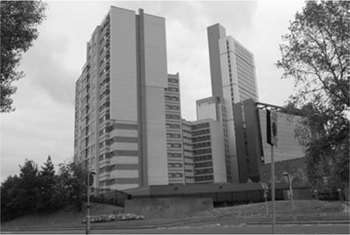
Sky Plaza
The plan is ambitious, pulling together several blocks of student flats to form a skyline, and it fails on every possible level, with its mean, tiny windows, its chillingly blank façade, its desperate boredom. To design a tower as minimal as this means that at least some effort must be made with proportions and materials, some attempt at elegance; but here grey cladding and a green lift tower seem almost calculatedly crap. Students are a captive market, and by providing extremely tight security (the Unite ‘village’, of which Sky Plaza is the centre, is gated), developers like Unite appeal to middle-class parents worried about the many appalling things that could happen to their children in the inner city. Given that this formula is enormously successful, what with the expansion both of university education and of paranoia, the architecture doesn’t have to be particularly interesting. This is, however, the first time an ex-industrial city has had a building for students as its tallest structure, and what it says about the ‘knowledge economy’ is incomparably depressing.

The eerie calm of Clarence Dock
It was not always thus. Leeds University in particular can boast one of the most impressive attempts to design an inner-city campus as a total, coherent environment, albeit without the need for CCTV and gating—the complex of university buildings designed by Chamberlin Powell and Bon between 1958 and 1968. Today it is alternately mutilated and commemorated. ‘The New Monumentality’, running through much of 2009 at the Henry Moore Institute, was an exhibition both about the Leeds campus and about architecture and everyday life, or rather about the disjunction between the two. The three artists represented, Dominique Gonzalez-Foerster, Gerard Byrne and Dorit Margreiter, all engaged with the fact that the strangest of buildings actually have to be lived in, and the latter two do so in the context of a building just round the corner from the gallery.
Local rumour has it that this complex served as a set for the seventies science fiction series Blake’s 7. This should come as no surprise. There is a divide in the perception of these buildings between the future they seem to suggest—a space-age society with egalitarian buildings that make no reference to anything so prosaic as local materials, human scale or history, which some of us may find liberating, others unnerving—and the past they are most often seen to represent. That is, the other 1960s, not the now very familiar decade reminisced over by ageing soixante-huitards but the decade of a new landscape of towers and slabs, walkways and motorways, which is only very slowly starting to come back into favour after decades in which it was abhorred by many as an example of top-down quasi-totalitarianism, often better known for its transformation into film-set dystopias at the hands of Kubrick, Truffaut or Antonioni.
The Leeds Campus
At the Henry Moore Institute, the most appropriately cinematic of the three works is Gerard Byrne’s film subject. On three screens, in glorious, lustrous monochrome, earnest Yorkshire youth talk to the camera. They’re dressed in seventies clothing, though you can’t quite guess whether this is because they’re in period costume or are merely fans of vintage fashion. They’re reading contemporary texts on familiar, kitsch sixties matters—ESP, promiscuity, the legalization of cannabis, taken from the student press of the time—in a bracingly unusual space. Byrne tries to normalize the campus, make it part of history once again, rather than the heavily contested remnant of the future’s past that it so clearly is. Yet as his camera lingers round the flying walkways, the jutting lecture theatres and the scintillating artificial surfaces, the eye is drawn to exactly this impossible strangeness, resisting the attempt to impose the signifiers of the sixties onto it, refusing to be made retro.
That the University doesn’t know what to do with the campus is obvious enough. In early photos, you can see the central space occupied by the sculpted nature of a planned garden, akin to the designs of the Brazilian landscape artist Roberto Burle Marx. In recent years the University filled the whole space with such a quantity of street furniture, foliage and inelegant public art that you can almost ignore the building. Meanwhile the concrete—sculptural, shuttered stuff similar to that used in Chamberlin Powell and Bon’s hugely successful Barbican complex in London—was painted in estate-agent magnolia, and the halls of residence are being demolished, it being easier to house students in the barracks provided by the likes of Unite. The old campus is a place that simply cannot make sense in the present, yet this might be what is most valuable about it. In Dorit Margreiter’s Aporia the unreadable abstraction of the campus is juxtaposed with an itinerary of theme parks and reconstructions, these hypercapitalist spaces a sharp contrast to a barely remembered social democracy and its abhorred architecture. The surrounding area provides its own argument, with the underpasses leading to enclaves like Sky Plaza. The University itself is still capable of commissioning good buildings—the twisted tower of Leeds Metropolitan University’s Arts and Humanities Department, designed by Fielden Clegg Bradley, is easily the best new tower in Leeds, although the competition is not exactly stiff. It’s clad, like all the others, but here the corten steel panels are designed to age gracefully, while the other towers seem not to be aware of the concept of ‘weathering’.
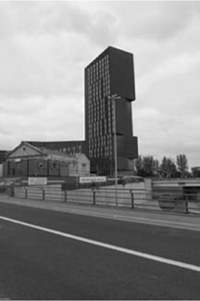
Metropolitan University Tower
Both Leeds and Bradford have extremely aggressive ring roads, but somehow Leeds’ underpasses do less damage, while the wide dual carriageways and inexplicably Portland stone-clad sixties towers in Bradford create ghettos as easily as any housing allocation policy. The Leeds system feels more permeable, less like a barrier, because you pass over the traffic, you are not directly inconvenienced by it—though the pedestrian bridges can be decidedly bracing. What makes it unpleasant is not the planning so much as the architecture. It’s an enduring irony that John Thorp, Leeds’ city architect, the last of his kind in any major city and mainly employed as a designer of ‘public realm’ rather than buildings, has personally authorized the development of these towers. Not because it’s a bad idea in principle, but because of the relentlessly shabby quality of the results.
Sky Plaza I’ve mentioned, but there are others almost as bad, and from their vicinity we literally see the destruction of the Leeds International Pool, by far the finest work of Leeds’ most famous architectural firm—John Poulson, the corrupter of Maudling, British Rail and T. Dan Smith, headed by a man who may apparently have barely held a pencil, let alone designed a whole building. Ambitious young journalist like yourself … We had a good view of the diving board from the walkway over the underpass. Preserved nearby above the central station is the hopelessly lumpen tower Poulson bribed his way to designing, as if to prove the irrelevance of quality or originality in the architectural pecking order. The International Pool was originally supposed to be succeeded by an Iconic tower called ‘The Spiracle’. That was cancelled, but the demolition proceeded as planned, as an incentive to any future developer.
The demise of Leeds International Pool
At the ring road, outside the Simon Jenkins-friendly Victoriana, you are faced with what is indisputably the worst new architecture of any major British city. What makes it even more worrying is its massive, unavoidable scale. There are several reclads of sixties towers, with the hat worn by ‘K2 The Cube’ easily the silliest, but the new towers are worse. The Opal Tower, a design and build project nominally by Morrison Design, is nearly as tall and as mean as Sky Plaza, again providing en-suite bedrooms for the city’s ruthlessly exploited student population, but this time more clunky than horrifying. Then there are innumerable fifteen-storey blocks by Carey Jones, devoid of real public spaces but clad in contextual terracotta. By comparison to this lot, Aedas’s reviled Carbuncle Cup-nominated Bridgewater Place is not so bad—at least its clash of shapes has a vestigial futurism, the ghost of an idea. The combination of local references, incredibly clumsy massing and the walled-off wasteland in front of Carey Jones’s West Point constitutes one of the clearest images we could find of the results of the financial crisis and the thinking that led to it. Leeds has been in the grip of a bitter strike over rubbish collection, with the city council taking a hard-line class war approach to the binmen, but we don’t notice it until we check the local press that evening. 2009 is a ‘reverse 1979’, so the images are different: ‘luxury’ turning empty and desolate rather than the collapses of council housing and consensus that marked punk mythology; no mountains of rubbish in the street, at least not yet. Surely the worst of all is Halliday Clark’s Mill Street Student Accommodation, like a PFI hospital stretched vertically into a block of flats, a wavy blue roof atop an incredibly badly built chequerboard façade. The designers call the building ‘vibrant and purposefully controversial’, which is one way of putting it. The windows are again horribly mean—for some reason students are not allowed normal-sized windows in their flats, and must instead look out of these tiny slits, presumably designed to discourage auto-defenestration.
Opal Tower and a rehabilitated sixties block
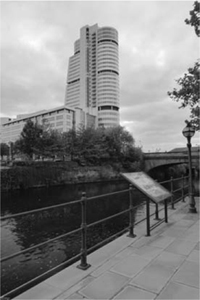
Bridgewater Place
West Point
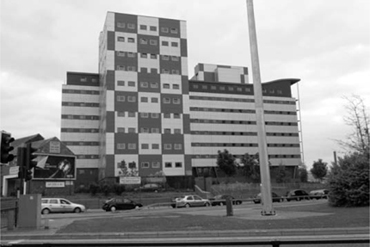
Leeds’ nadir
While central Leeds’ ring roads and inhospitable corners are impeccably regenerated via this sort of hostile, pedestrian-unfriendly architecture, there is one end of central Bradford that regeneration has barely even scraped, despite having unimpeachable traditional urban credentials that would warm Simon Jenkins’ heart. A Bradford Civic Society brochure entitled Common Sense Regeneration that we pick up from the Bradford Club, the Lockwood and Mawson-designed Old Liberal Club which we manage to blag our way into for lunch (apparently it hasn’t been distributed far outside of such rarefied circles), calls it ‘Goitside’ (no Bradfordian we mention this to admits to using the term). In between blasts at most of what has happened since 1939, the writers recognize the remarkable quality of Goitside in architectural terms, and the depths to which it has sunk.61 From here you get an awesome view, with the Yorkshire stone sides of BDP’s late sixties Bradford University tower fitting perfectly with the landscape (on the other side, sky-blue cladding has been added in an act of sheer architectural illiteracy). There are several derelict wool warehouses, but what really hits you is the city’s earliest council housing—1900s tenements, low-rise, arts and crafts. They are littered both with bright, well-meaning public art from when people did live here, and the needles and foil left by those who are using in the flats’ derelict shells. The smell is foul.
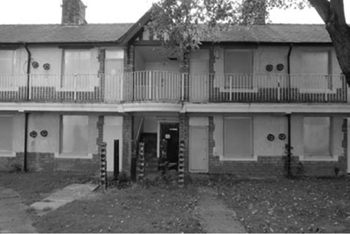
Bradford’s first council housing
‘Best Among Ruins’
We gradually twig that there’s something we’ve been seeing practically everywhere in West Yorkshire, and which we then realize we’ve seen nearly everywhere else as well—the ubiquitous fences, usually marking off sites ‘for development’, customarily painted a pinkish purple, with graffiti usually scrubbed off as quickly as possible and heavy security patrolling the weeds. The ultimate example of this is the snaking wall that encloses the Westfield Hole in Bradford, but we find so many others: by West Point in Leeds; in front of Halifax Town Hall next to a sign pointing towards its regenerated ‘quarters’; and enclosing random spots in Wakefield. The realization comes after we visit an exhibition in Bradford’s National Media Museum on Don McCullin, who is quoted there saying ‘visually, you just can’t lose in Bradford’. He photographed the area in the late 1970s, showing huge amounts of dead and derelict space. At first we wonder where this has all gone, given the rash of cancelled projects, but the bright fences are the explanation, the happy result no doubt of health and safety regulations. They screen the wasteland—the most obvious sign of failure—from the public. After the Blitz and at massive human cost, the scarred cities created a feeling of ‘light and openness’ in the formerly overcrowded areas. These holes run through postwar art, music and architecture, creating a new conception of space, a sense of airiness and possibility which is still palpable in parts of Sheffield or Manchester where the fence-makers haven’t arrived yet. Mostly, however, these bright barriers dressed with property propaganda practically scream at pedestrians to move on, telling them not to pause to look at what’s behind the door, assuring them with grinning desperation that EVERYTHING IS GOING TO BE OK. The anonymous sloganeers of Bradford know exactly what’s going on, however, and they subjected the fence to a relentless campaign of ridicule via graffito for as long as it stood. At the time of writing, in early 2010, there are plans to remove the fences and sculpt the wasteland into a new park. Officially, it will be temporary, the site still owned by Westfield in case they ever decide they do want to build a mall in Bradford, but nonetheless this is a small victory that Bradford ought to savour. This place is still being dumped upon from a great height, and they know it. Maybe they ought to found an Independent Labour Party.